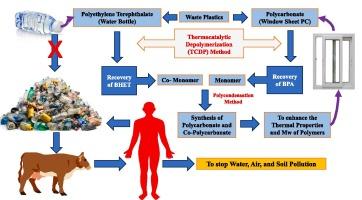Sustainable recovery of monomers from PET and PC waste via Thermocatalytic depolymerization for synthesis of polycarbonates and co-polycarbonates
IF 5.8
2区 化学
Q1 POLYMER SCIENCE
引用次数: 0
Abstract
The increasing global demand for sustainable plastics recycling methods has propelled the research and development of innovative depolymerization processes. The Thermocatalytic depolymerization (TCDP) of polyethylene terephthalate (PET) and polycarbonate (PC) has been performed at 200 ℃. Ethylene glycol (EG) is used as a reactant and as well a polymer bond-cleaving agent and Yttrium Oxide (Y2O3) is used as an effective catalyst. Y2O3 acted as a dual role during depolymerization reaction, which converts EG into cyclic ethylene oxide (CEO) and as well as to break the ester and carbonate bonds in the polymer structure of PET and PC respectively. The TCDP reaction conditions were optimized and the maximum quantity of Bis(2-hydroxyethyl) terephthalate (BHET) (80%) and (Bisphenol A (BPA)) (83%) has been recovered by TCDP reaction of PET and PC respectively. The polycarbonate and co-polycarbonate (Co-PC) were synthesized using recovered BPA and BHET with triphosgene via polycondensation reaction. The structure of monomers and polymers was confirmed by existing analytical (FTIR, NMR, XRD and GPC) techniques. The thermal properties of PC and Co-PC were performed by TG analysis. The TGA results reveal that the degradation temperature (Td) of PC and Co-PC are observed at 420.5 and 442.8 °C respectively, which shows that the Td of Co-PC has been increased by 22 ℃ than PC. The TCDP process is an effective method to recover specific value-added products from waste plastics, which could be made into a new versatile material for different applications. This research finding will provide a new direction to convert plastic waste into useful chemicals, which could reduce waste plastic and their carbon footprint and contribute to a more sustainable future by reusing plastic materials and achieving a circular economy.

通过热催化解聚从 PET 和 PC 废弃物中可持续回收单体,用于合成聚碳酸酯和共聚碳酸酯
全球对可持续塑料回收方法的需求日益增长,推动了创新型解聚工艺的研究和开发。聚对苯二甲酸乙二酯(PET)和聚碳酸酯(PC)的热催化解聚(TCDP)在 200 ℃ 下进行。乙二醇(EG)用作反应物和聚合物键裂解剂,氧化钇(Y2O3)用作有效催化剂。Y2O3 在解聚反应中起着双重作用,既能将 EG 转化为环氧乙烷 (CEO),又能分别断开 PET 和 PC 聚合物结构中的酯键和碳酸键。通过优化 TCDP 反应条件,PET 和 PC 的 TCDP 反应分别回收了 80% 的对苯二甲酸二(2-羟乙基)酯 (BHET) 和 83% 的双酚 A (BPA)。利用回收的双酚 A 和 BHET 与三光气通过缩聚反应合成了聚碳酸酯和共聚碳酸酯(Co-PC)。单体和聚合物的结构通过现有的分析(傅立叶变换红外光谱、核磁共振、X 射线衍射和 GPC)技术得到了确认。PC 和 Co-PC 的热性能是通过 TG 分析得出的。TGA 分析结果显示,PC 和 Co-PC 的降解温度(Td)分别为 420.5 ℃ 和 442.8 ℃,这表明 Co-PC 的 Td 比 PC 提高了 22 ℃。TCDP 工艺是一种从废塑料中回收特定高附加值产品的有效方法,可将其制成不同用途的新型多功能材料。这项研究成果将为把废塑料转化为有用的化学品提供一个新方向,从而减少废塑料及其碳足迹,并通过重复使用塑料材料和实现循环经济,为更可持续的未来做出贡献。
本文章由计算机程序翻译,如有差异,请以英文原文为准。
求助全文
约1分钟内获得全文
求助全文
来源期刊

European Polymer Journal
化学-高分子科学
CiteScore
9.90
自引率
10.00%
发文量
691
审稿时长
23 days
期刊介绍:
European Polymer Journal is dedicated to publishing work on fundamental and applied polymer chemistry and macromolecular materials. The journal covers all aspects of polymer synthesis, including polymerization mechanisms and chemical functional transformations, with a focus on novel polymers and the relationships between molecular structure and polymer properties. In addition, we welcome submissions on bio-based or renewable polymers, stimuli-responsive systems and polymer bio-hybrids. European Polymer Journal also publishes research on the biomedical application of polymers, including drug delivery and regenerative medicine. The main scope is covered but not limited to the following core research areas:
Polymer synthesis and functionalization
• Novel synthetic routes for polymerization, functional modification, controlled/living polymerization and precision polymers.
Stimuli-responsive polymers
• Including shape memory and self-healing polymers.
Supramolecular polymers and self-assembly
• Molecular recognition and higher order polymer structures.
Renewable and sustainable polymers
• Bio-based, biodegradable and anti-microbial polymers and polymeric bio-nanocomposites.
Polymers at interfaces and surfaces
• Chemistry and engineering of surfaces with biological relevance, including patterning, antifouling polymers and polymers for membrane applications.
Biomedical applications and nanomedicine
• Polymers for regenerative medicine, drug delivery molecular release and gene therapy
The scope of European Polymer Journal no longer includes Polymer Physics.
 求助内容:
求助内容: 应助结果提醒方式:
应助结果提醒方式:


